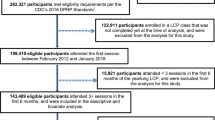Abstract
Diabetes prevention requires lifestyle changes, and traditional educational programs for lifestyle changes have had low attendance rates in ethnic populations. This article describes the development and implementation of an educational program, emphasizing retention strategies, cultural tailoring and community participation. Community-based participatory research approaches were used to adapt and test the feasibility of a culturally tailored lifestyle intervention (named Health is Wealth) for Filipino-American adults at risk for diabetes (n = 40) in order to increase program attendance. A unique feature of this program was the flexibility of scheduling the eight classes, and inclusion of activities, foods and proverbs consistent with Filipino culture. We found that with this approach, overall program attendance for the experimental and wait-listed control groups was 88% and participant satisfaction was high with 93% very satisfied. Flexible scheduling, a bilingual facilitator for the classes, and the community-academic partnership contributed to the high attendance for this lifestyle intervention.

Similar content being viewed by others
References
Davis M, Addis M. Predictors of attrition from behavioral medicine treatments. Ann Behav Med. 1999;21:339–49.
Finley CE, Barlow CE, Greenway FL, Rock CL, Rolls BJ, Blair SN. Retention rates and weight loss in a commercial weight loss program. Int J Obes. 2007;31(2):292–8.
Mau M, Kaholokula J, West M, Leake A, Efferth J, Rose C, Palakiko D, Yoshimura S, Kekauoha P, Gomes H. Translating diabetes prevention into Native Hawaiian and Pacific Islander communities: The PILI ‘Ohana Pilot Project. Prog Community Health Partnersh Res. 2010;4(1):7–16.
Pan XR, Li GW, Hu YH, et al. Effects of diet and exercise in preventing NIDDM in people with impaired glucose tolerance: The Da Qing IGT and diabetes study. Diabetes Care. 1997;20(4):537–44.
Tuomilehto J, Lindström J, Eriksson JG, et al. Prevention of type 2 diabetes mellitus by changes in lifestyle among subjects with impaired glucose tolerance. N Engl J Med. 2001;344:1341–50.
Knowler WC, Barrett-Connor E, Fowler SE, et al. Reduction in the incidence of type 2 diabetes with lifestyle intervention of metformin. N Engl J Med. 2002;346(6):393–403.
Bonus R. Locating Filipino Americans: ethnicity and the cultural politics of space. Philadelphia, PA: Temple University Press; 2000.
US Census Bureau: The American community—Asians: 2004 (American Community Survey Reports). US Department of Commerce Economics and Statistics Administration Web site. Available at: www.census.gov/prod/2007pubs/acs-05.pdf. Issued February 2007. Accessed 8 June 2007.
Terrazas, A. Filipino immigrants in the United States. Washington, DC: Migration Policy Institute. 2008. Available at http://www.migrationinformation.org/usfocus/print.cfm?ID=694.
Araneta MR, Wingard DL, Barrett-Connor E. Type 2 diabetes and metabolic syndrome in Filipina-American women: a high-risk non-obese population. Diabetes Care. 2002;25(3):494–9.
Furubayashi JK, Look MA. Type 2 diabetes in Native Hawaiians and Pacific Islanders in Hawaii. Pac Health Surveill Response. 2005;12(2):103–10.
Grandinetti A, Chang HK, Theriault A, Mor J. Metabolic syndrome in a multiethnic population in rural Hawaii. Ethn Dis. 2005;15(2):233–7.
National Cholesterol Education Program Expert Panel. Third Report on Detection, Evaluation, and Treatment of High Blood Cholesterol in Adults (Adult Treatment Panel III) (Final Report). Circulation. 2002;106:3143–3421.
Leake A, Oculto T, Ramones E, Caagbay C. Diabetes bingo: research prioritization with the Filipino community. Hawaii Med J. 2010;69:237–41.
Hawaii State Department of Health. Healthy People 2010. Honolulu, HI: Author; 2006.
Bandura A. Social learning theory. Englewood Cliffs, NJ: Prentice Hall; 1977.
Bandura A. Self-efficacy: the exercise of control. New York: H. Freeman & Co; 1997.
Cantos A, Rivera E. Filipinos. In: Lipson J, Dibble S, Minarik P, editors. Culture and nursing care. San Fransisco: UCSF Nursing Press; 1996. p. 115–25.
Ruge T, Nystrom L, Lindahl B, Hallmans G, Norberg M, Weinehall L, Rolandsson O. Recruiting high-risk individuals to a diabetes prevention program. Diabetes Care. 2007;30(7):e61.
Wallace MF, Fulwood R, Alvarado M: NHLBI step-by-step approach to adapting cardiovascular training and education curricula for diverse audiences. Prev Chronic Dis. 2008; 5(2). Available at http://www.cdc.gov/pcd/issues/2008/apr/07_0201.htm. Accessed 1 August 2010.
Abe-Kim J, Gong F, Takeuchi D. Religiosity, spirituality and help-seeking among Filipino Americans: religious clergy or mental health professionals? J Community Health. 2004;32(6):675–89.
UyBico SJ, Pavel S, Gross CP. Recruiting vulnerable populations into research: a systematic review of recruitment interventions. J Gen Intern Med. 2007;22(6):852–63.
Yancey AK, Ortega AN, Kumanyika SK. Effective recruitment and retention of minority research participants. Annu Rev Public Health. 2006;27:1–28.
Maxwell A, Bastani R, Vida P, Warda US. Strategies to recruit and retain older Filipino-American immigrants for a cancer screening study. J Community Health. 2007;30(3):167–79.
Acknowledgement
Funded by NIH/NINR #5P20NR010671 Center for Ohana Self-management of Chronic Illness.
Author information
Authors and Affiliations
Corresponding author
Rights and permissions
About this article
Cite this article
Leake, A.R., Bermudo, V.C., Jacob, J. et al. Health is Wealth: Methods to Improve Attendance in a Lifestyle Intervention for a Largely Immigrant Filipino-American Sample. J Immigrant Minority Health 14, 475–480 (2012). https://doi.org/10.1007/s10903-011-9487-0
Published:
Issue Date:
DOI: https://doi.org/10.1007/s10903-011-9487-0




